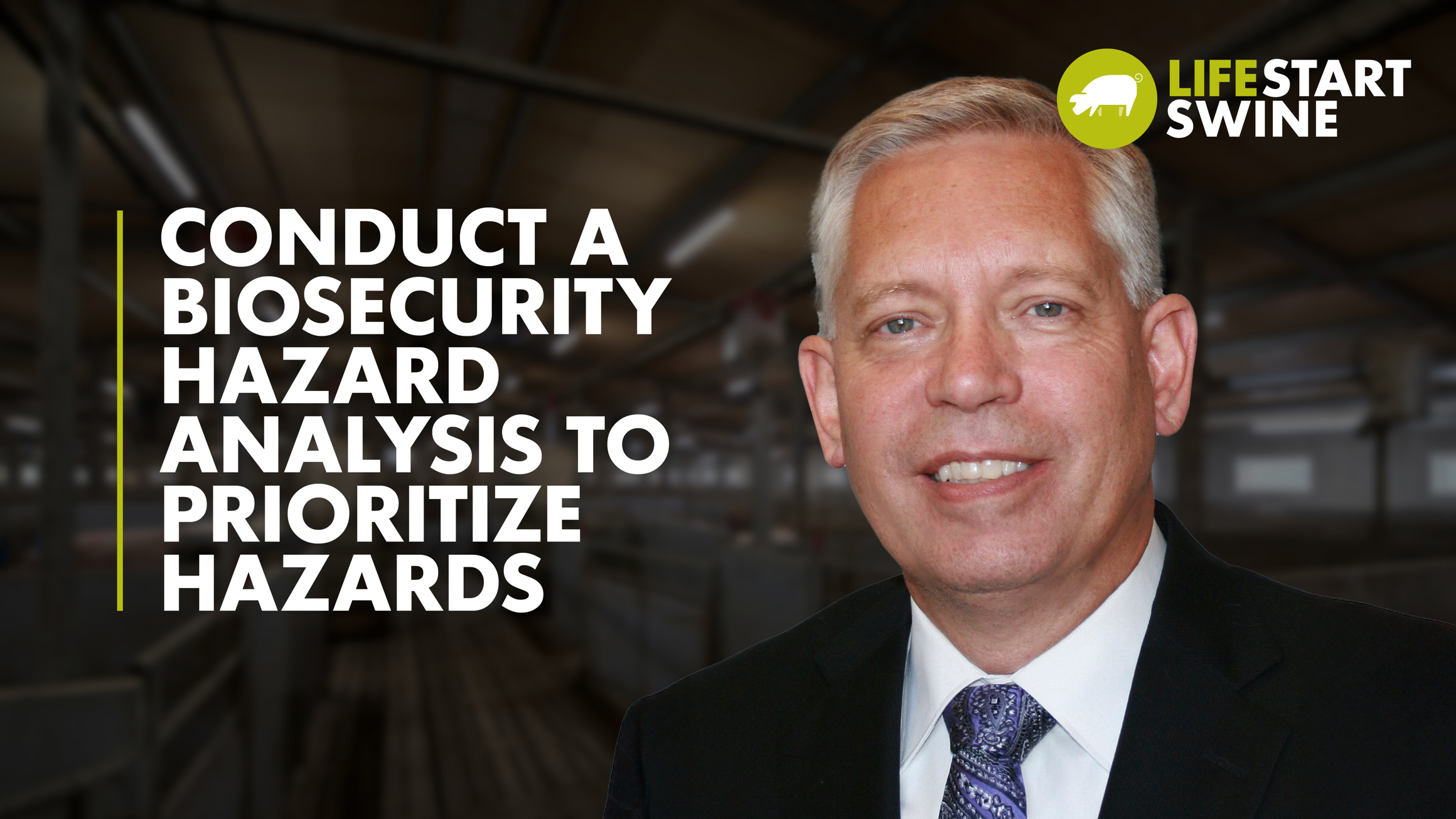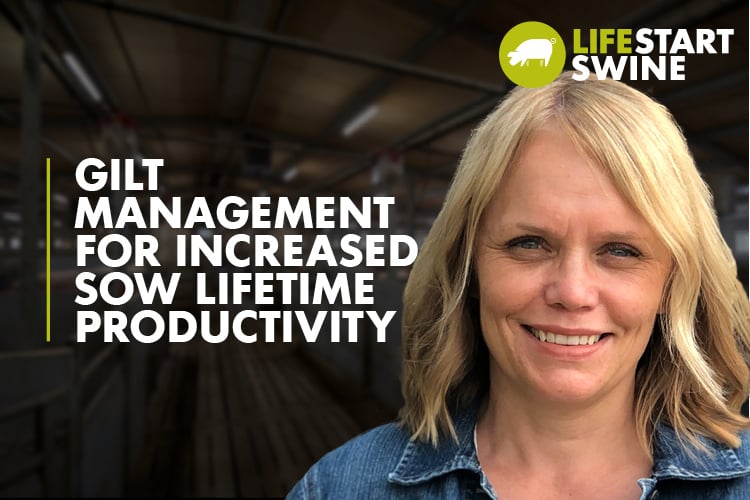
Conduct a Biosecurity Hazard Analysis to prioritize hazards before or after a disease outbreak
- 2024
- EARLY LIFE
A systematic approach to biosecurity helps identify where changes are needed
Sarah Mikesell, editor of The Pig Site and in collaboration with LifeStart Swine, interviews Dr. Derald Holtkamp, professor of swine production medicine at Iowa State University in Ames, Iowa, USA. Dr. Holtkamp focuses on the management of infectious swine diseases, biosecurity disease risk assessment and the economics of animal health and disease with an emphasis on porcine reproductive and respiratory syndrome (PRRSV) and porcine epidemic diarrhea virus (PEDV).

Assessing biosecurity risks on the farm
Modern pork production around the world has revolutionized how we raise pigs. Once mainly closed farrow-to-finish farms of independently-owned producers, operations have evolved into a largely open-production system today. With this comes an increased need to analyze biosecurity risks on the farm.
“If you go back 30 or 40 years, producers had labor and an on-site feed mill, meaning they were not bringing in things to the farm on a regular basis,” says Holtkamp. “Fast forward to today. Now we’re bringing things in all the time. For example, we bring in employees every day, and feed and semen several times a week. Now we have many opportunities for pathogens to enter the farm.”
Looking at other biological industries such as food, ethanol or biopharmaceuticals gives pork producers systems of comparison. Such industries strive to create what would be described as a closed biological production system.
“In biological industries, the introduction of bacteria, viruses and other things can really wreak havoc, especially at the wrong time,” Holtkamp says. “Historical models of pork production have prioritized cost efficiency. Now, we’ve been working on an approach over the last 10 years or more to assess biosecurity hazards.”
Standardized outbreak investigation program
Holtkamp has been studying outbreak investigations, looking back over the last 10 to 15 years. He has studied how people, especially veterinarians, completed these investigations and how they used the information they learned.
Understanding that these responses have been all over the board and very ad hoc, Holtkamp determined the industry needs a more systematic and comprehensive approach. Thus, a group of veterinarians with select academics formed a working group to create a Standardized Outbreak Investigation Program, with funding from the Swine Health Information Center and endorsed by the American Association of Swine Veterinarians.
“We’re really promoting a standardized way of doing outbreak investigations,” Holtkamp says. “By using a systematic and comprehensive approach, we can collect data from multiple outbreak investigations and start to learn from that. No matter what country you're in, I think it's important to recognize that these outbreak investigations are great opportunities to learn and identify the high-priority hazards to better devote your resources.”
What is a Biosecurity Hazard Analysis?
This approach, called Biosecurity Hazard Analysis, requires looking at the entire production process and analyzing the details. The first step of the process is analyzing where the hazards lie. It is important to identify the WHO, WHAT, WHEN, WHERE and HOW of the whole production process.
- Who does things?
- How do they do them?
- When do they do them?
- What are they doing?
It is important to look at all aspects of the production process, including the operational procedures, the structural (e.g. building designs, site layouts), and the resource (e.g. tools, equipment and training) employees have to complete the operational procedures to reduce or eliminate biosecurity hazards.
When should producers conduct a biosecurity hazard analysis?
Arguably, the time to assess biosecurity hazards is before an outbreak occurs. However, in practice, it is human nature to respond more energetically in crisis.
“For example, let’s look at an outbreak on sow farms,” says Holtkamp. “PRRS virus or PEDV on sow farms is a crisis. This is a time when producers and veterinarians are most interested and willing to spend time doing a biosecurity hazard analysis and taking action. So, we’re not going to prevent the outbreak that already happened, but an analysis at this time is a good way to prevent the next outbreak.”
Another example of learning from an outbreak is when African swine fever virus hit China. The fear of a crisis necessitated a response from here in the United States. Sometimes an outbreak at a neighboring farm requires a look at practices.
Who is involved?
The group has identified, at a minimum, the people needed at the table to start the investigation:
- the farm manager or the site caretaker, and
- the herd veterinarian.
The goal of the initial investigation is to identify those areas that may be high-risk and warrant resources to address. The process helps operations identify priority areas, so the people involved can address those priorities based on that information.
“Frequently, there's follow-up. For example, the herd veterinarian and farm manager may not know a lot about what happens at the truck wash,” Holtkamp says. “They may just know generally, for example, the trucks are supposed to get washed, disinfected and dried. We start drilling down on the details, asking questions: How do they get rid of the organic matter? Do they flush? What disinfectant do they use? What concentration is used? How do they apply?”
Many times, if producers haven't been to the site recently or haven't been involved in those discussions, they don't know all the answers. The questions motivate them to find out. The results identify areas requiring attention. If follow-up is warranted, the group can bring together the appropriate people. This may include people involved in transport, those making decisions or those responsible for making them happen. It varies by system because each production system is different.
Where should biosecurity practices or control measures be implemented?
According to Holtkamp, during the outbreak investigation, the group looks at what they describe as Entry Events. Examples are entry of feed or removal of dead pigs. Then, the group subjectively rates Entry Events as high, medium or low. This creates a picture of the most significant problems.
“We recently completed an investigation where we identified that dead removal was the most significant problem and had the most biosecurity hazards with it,” Holtkamp says. “And we had a follow-up call with the veterinarians and upper management on the phone and discussed more about processes of dead removal. In the end, we had the foundation for producers to address how to fix things.”
In some cases, simple process changes improve the biosecurity on the farm. Biosecurity Hazard Analysis helps lay the groundwork for operations to do that. The outbreak investigation helps producers ask the right questions and work through them. This is a process that helps them get started.
“In this example, it will take several more conversations for them to assess,” says Holtkamp. “It requires stepping back and asking, ‘What do you think we can do? What fits within our production system? Do we have the resources to invest in that right now?’”
Analyses help identify high risk areas
Each farm is unique. However, by digging into these outbreak investigations over the years, Holtkamp and his students learned what to look at and where to improve practices.
“I would say over the last 20 years of biosecurity, the industry has effectively focused on entry of semen and entry of gilts,” Holtkamp says. “Our investigations have shown us that the operational procedures and resources in place for these are pretty good. Not perfect, but good. Now, we’ve identified that there are issues with things like employee entry.”
Three areas have been identified as most common hazards for high-risk Entry Events, including:
- employee entry
- cull sow removal
- repair events done inside the barn
EMPLOYEE ENTRY
The analyses help identify, firstly, that employee entry is the most frequent Entry Event occurring on sow farms. In fact, graphs show the frequency of those events: the employee entry events with everything else falling to the bottom.
Secondly, operations should recognize they have almost no control over employees and what they do when they're away from the farm. Some rules can be put in place, but there aren’t really good ways to monitor that risk.
“This puts a lot of pressure on trying to mitigate any contamination of employees before they enter the farm,” says Holtkamp. “For many years, producers primarily relied on showers to do that. We saw lots of problems with that, such as towels on the dirty side of the shower and shower designs where there’s not a true line of separation.”
CULL SOW REMOVAL
With sow removal, even though animals aren’t coming in, a truck and driver are coming onto the farm. Frequently, how the removals are being completed comes with hazards.
BARN REPAIR EVENTS
Often, barn repair events are emergencies. Because repairs need to be done right away, people take shortcuts. Further, the people doing the repairs don’t necessarily like to be told procedures to follow or when to do their work. In many cases, a veterinarian will say how things happen, but further investigation talking to the people doing the repairs reveals that’s not how it happens.
“These are things we've commonly seen, but a hazard could be anywhere,” Holtkamp says. “That is why it is important to do a Biosecurity Hazard Analysis. The investigation needs to be systematic and comprehensive, walking through all of the production processes of the operation. This gives us the confidence that we have collected enough information to invest time and resources to fix things.”


